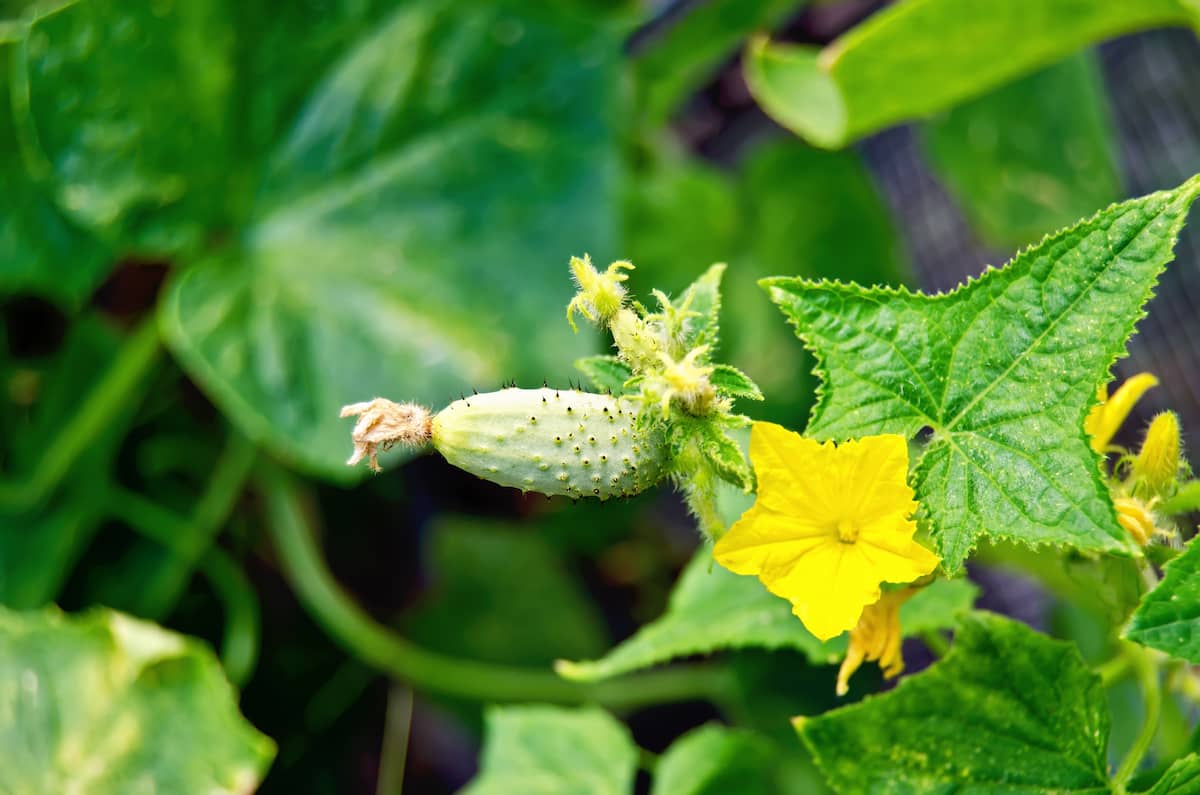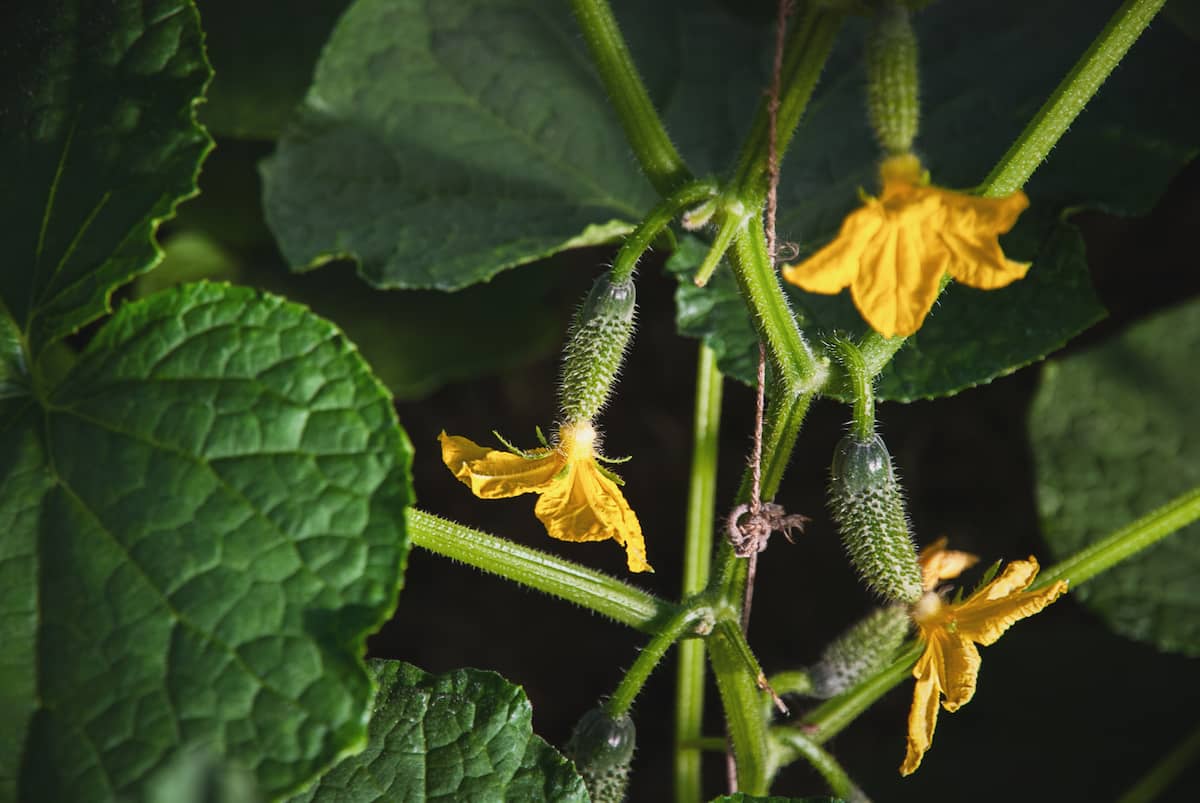Cucumber is a valuable vegetable crop worldwide, but a common issue growers need is the need for more female flowers, leading to low yields. Female flowers are crucial for fruit development, making their production vital for a successful harvest. Factors such as temperature, light, nutrition, and genetics can affect the number of female flowers.

Research has revealed that high temperatures can reduce female flower production, while cooler temperatures increase it. Longer hours of light can also enhance female flower development. Adequate potassium, phosphorus, and calcium levels positively impact female flower numbers. Appropriate management of environmental factors and nutrition can improve cucumber crop yield and quality by up to 30%.
How to Increase Female Flowers in Cucumber
Introduction to Cucumber Cultivation
Cucumber cultivation is a widely practiced agricultural activity globally. It involves growing cucumbers, a popular and highly valuable vegetable crop with numerous nutritional benefits. Cucumber cultivation requires adequate soil preparation, appropriate nutrients, and careful management of environmental factors such as temperature, humidity, and light.
The crop can be grown in various farming systems, including open fields, greenhouses, or hydroponics. Proper pest and disease control measures are also essential for successful cucumber cultivation. Cucumber demand continues to rise, making cucumber cultivation a lucrative enterprise for farmers worldwide.
Understand the Anatomy of Cucumber Flowers
Cucumber flowers are an important component of the reproductive system of cucumber plants. They are either male or female, and their distinct anatomy reflects their function in the reproductive process. The male flowers have long, thin stems and consist of a single stamen that produces pollen. On the other hand, the female flowers have a swollen ovary at the base of the flower that develops into the fruit.
The female flowers also have a stigma, which is receptive to pollen, and a style that connects the stigma to the ovary. Cucumber flowers have a variety of floral parts, including sepals, petals, stamens, pistils, and anthers. The sepals form a protective covering for the flower bud, while the petals visually attract pollinators. The anthers, found in the male flowers, produce pollen, while the pistils, found in the female flowers, contain the ovules that develop into seeds after fertilization.
Best Variety of Cultivation Cucumber
Cucumber is a versatile vegetable with a wide range of varieties for cultivation. The Armenian cucumber has a slender, slightly curved shape and a mild flavor, while the Lemon cucumber is round and yellow with a sweet taste. The Persian cucumber is thin-skinned with a mild flavor and crisp texture. English cucumber has a long, thin shape with a mild, slightly sweet taste, and Suyo Long cucumber has dark green skin and a crisp, sweet taste.
The National Pickling cucumber is small and blocky, ideal for pickling, while Marketmore cucumber has medium-sized, dark green skin with a mild flavor. Diva cucumber is a seedless variety with a thin skin and a sweet, crisp taste, and Straight Eight cucumber has a classic medium-sized straight shape with a mild flavor. Bush Champion cucumber is a compact, bushy variety with a high yield and a crisp, sweet taste, while Sweet Success cucumber has a long, straight shape with a thin skin and a sweet, crisp taste.
Optimal Growing Conditions for Cucumber
Cucumbers are a warm-weather crop and require soil and air temperatures between 60 and 90 degrees Fahrenheit for optimal germination. The ideal outdoor temperature for growing cucumbers is between 65 and 75 degrees Fahrenheit. They need full sun but benefit from shade in hotter areas. Adequate water, mulch, and well-drained soil with a pH between 6.0 and 7.0 are essential for cucumber plants’ thrive. It’s crucial to side-dress with compost when the first runners develop and again when the flowers start.
In case you missed it: How to Increase Female Flowers in Chilli Peppers: Explained in 10 Simple Steps

Cucumber Flowering Stage
Cucumber plants are typically monoecious, meaning they must consist of male and female flowers on the same plant. Male flowers usually appear about 35 days after the plant has sprouted, while female flowers emerge around ten days later. Female flowers can be easily distinguished from male flowers by a bulge behind them that looks like an immature cucumber. This bulge is the flower’s ovary, and it develops into a cucumber in 7-21 days once it has been pollinated.
Factors that Affect Less Female Flowers in Cucumber
- Monoecious plants produce male flowers first to attract pollinators for reproduction and female flowers about two weeks later.
- Male flowers always outnumber female flowers in monoecious varieties, ensuring enough pollen.
- Gynoecious varieties are hybrid plants that produce primarily female flowers, while parthenocarpic varieties produce fruit without pollination.
- Large operations usually purchase Gynoecious and parthenocarpic seeds, while home gardeners typically plant monoecious varieties.
- Poor nutrition can cause a lack of female flowers, so it’s essential to fertilize the plant accordingly. Container gardens tend to lose nutrition more quickly than traditional gardens.
- Lack of sunlight can also cause a lack of female blooms, and fruit-bearing plants require a minimum of six hours of full sun.
- Environmental stress, such as improper watering, insect pressure, excessive heat, or cold snaps, can interrupt the production of female flowers. Alleviating these conditions can help the plant produce female flowers.
10 Simple Tips to Increase Female Flowers in Cucumber
- Plant more gynoecious cucumber plants in cooler temperatures (40-60°F) and spring.
- Water the soil with about 2 inches twice a week and control weeds to prevent moisture loss and nutrient competition.
- Balance the nitrogen fertilizer to avoid high concentration, which delays the growth of female flowers.
- Sow cucumber seeds indoors and lower the temperature after sprouting to encourage more female flower growth.
- Space cucumber plants 18-24 inches apart and use trellises or poles for air circulation.
- Add well-rotten compost to the soil before planting and create a tea for water plants.
- Prune cucumber plants with a wire cage or stick until enough female flowers are produced for better airflow.
- Use trellises or poles to support the plants and allow for better airflow.
- Add very well-rotted compost to the soil before planting and create compost tea to water the plants after three weeks in the ground.
- Avoid over-fertilizing with nitrogen or other nutrients.
Manual Pollination of Cucumber
Hand pollination of cucumber plants can be a tedious but effective method to increase the yield of large and mature cucumbers. It involves waiting until later flowers develop and recognizing the difference between male and female flowers. Male flowers grow in clusters of three to five with shorter stems, while female flowers bloom singly with a small ovary in the center and a small fruit at the base of the stem.
When hand pollinating, use only fresh male flowers, as the pollen is only viable during the day the flower opens. Pollen is sticky, so use a small, clean artist’s brush or remove the petals to transfer the yellow pollen from the male anther to the stigma in the center of the female flower. One male anther can pollinate several females. Repeat the process for effective hand pollination of cucumber plants.
In case you missed it: How to Increase Female Flowers in Bitter Gourd: A Guide of Bitter to Better

Conclusion
Several steps can be taken to increase the production of female flowers in cucumber plants. These include planting more gynoecious cucumber plants, controlling weeds and providing adequate water, balancing nitrogen fertilizer, sowing and planting more, spacing plants appropriately, using mulch and compost, and pruning the plants. Additionally, hand pollination can ensure that only the freshest male flowers are used to pollinate the female flowers, resulting in a more productive harvest.
- Ultimate Guide to Ossabaw Island Hog: Breeding, Raising, Diet, and Care
- Ultimate Guide to Juliana Pig: Raising Facts, Size, Diet, Care, and Lifespan
- Raising Lleyn Sheep: Disadvantages, Price, Uses, Characteristics, and Care
- Ultimate Guide to Meishan Pig: Breed Facts, Breeding, Raising, and Care
- Ultimate Guide to Teacup Pigs: Raising, Diet, Lifespan, Cost, and Care
- Guide to Raising Poll Dorset Sheep: Facts, Profile, Characteristics, Uses, and Care
- Ultimate Guide to Bighorn Sheep: Characteristics, Diet, Lifespan, Breeding, and Lifecycle
- Ultimate Guide to Raising Katahdin Sheep: Farming Facts, Breed Profile, Uses, and Care
- Ultimate Guide to Raising Oreo Cows: Belted Galloways Farming Facts, Profile, Uses, and Care